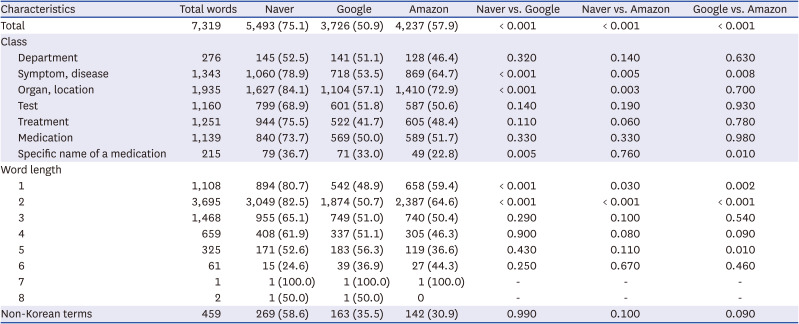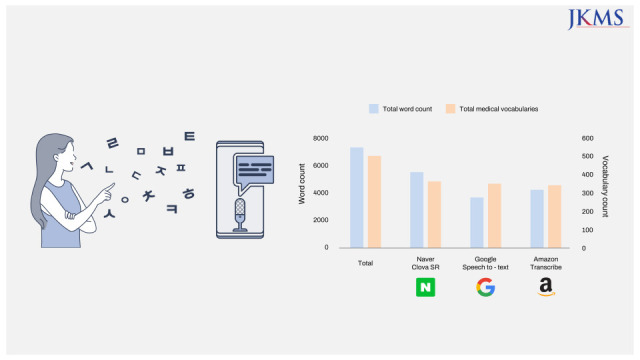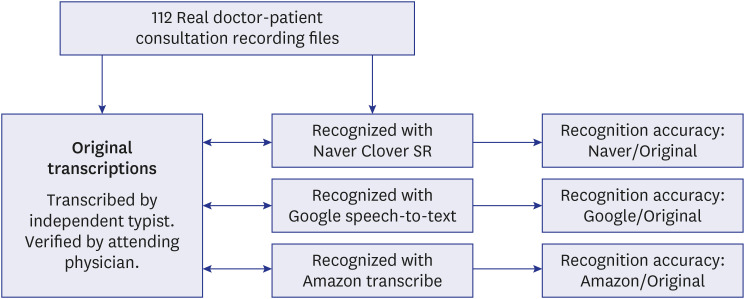1. Hodgson T, Coiera E. Risks and benefits of speech recognition for clinical documentation: a systematic review. J Am Med Inform Assoc. 2016; 23(e1):e169–e179. PMID:
26578226.
2. Zhou L, Blackley SV, Kowalski L, Doan R, Acker WW, Landman AB, et al. Analysis of errors in dictated clinical documents assisted by speech recognition software and professional transcriptionists. JAMA Netw Open. 2018; 1(3):e180530. PMID:
30370424.
3. Hinton G, Deng L, Yu D, Dahl G, Mohamed A, Jaitly N, et al. Deep neural networks for acoustic modeling in speech recognition: the shared views of four research groups. IEEE Signal Process Mag. 2012; 29(6):82–97.
4. Chiu CC, Sainath TN, Wu Y, Prabhavalkar R, Nguyen P, Chen Z, et al. State-of-the-art speech recognition with sequence-to-sequence models. In : Proceeding of the 2018 IEEE International Conference on Acoustics, Speech and Signal Processing (ICASSP); 2018 April 15–20; Calgary, Canada. Manhattan, NY, USA: IEEE;2018. p. 4774–4778.
5. Johnson M, Lapkin S, Long V, Sanchez P, Suominen H, Basilakis J, et al. A systematic review of speech recognition technology in health care. BMC Med Inform Decis Mak. 2014; 14:94. PMID:
25351845.
6. Yoo HJ, Seo S, Im SW, Gim GY. The performance evaluation of continuous speech recognition based on Korean phonological rules of cloud-based speech recognition open API. Int J Networked Distrib Comput. 2021; 9(1):10–18.
7. Spinazze P, Aardoom J, Chavannes N, Kasteleyn M. The computer will see you now: overcoming barriers to adoption of computer-assisted history taking (CAHT) in primary care. J Med Internet Res. 2021; 23(2):e19306. PMID:
33625360.
8. Elmore N, Burt J, Abel G, Maratos FA, Montague J, Campbell J, et al. Investigating the relationship between consultation length and patient experience: a cross-sectional study in primary care. Br J Gen Pract. 2016; 66(653):e896–e903. PMID:
27777231.
9. Sinsky C, Colligan L, Li L, Prgomet M, Reynolds S, Goeders L, et al. Allocation of physician time in ambulatory practice: a time and motion study in 4 specialties. Ann Intern Med. 2016; 165(11):753–760. PMID:
27595430.
10. Basma S, Lord B, Jacks LM, Rizk M, Scaranelo AM. Error rates in breast imaging reports: comparison of automatic speech recognition and dictation transcription. AJR Am J Roentgenol. 2011; 197(4):923–927. PMID:
21940580.
11. Kim D, Oh J, Im H, Yoon M, Park J, Lee J. Automatic classification of the Korean triage acuity scale in simulated emergency rooms using speech recognition and natural language processing: a proof of concept study. J Korean Med Sci. 2021; 36(27):e175. PMID:
34254471.
12. Kim S, Lee J, Choi SG, Ji S, Kang J, Kim J, et al. Building a Korean conversational speech database in the emergency medical domain. Phon Speech Sci. 2020; 12(4):81–90.
13. Kauppinen T, Koivikko MP, Ahovuo J. Improvement of report workflow and productivity using speech recognition--a follow-up study. J Digit Imaging. 2008; 21(4):378–382. PMID:
18437491.
14. Blackley BV, Schubert VD, Goss FR, Al Assad W, Garabedian PM, Zhou L. Physician use of speech recognition versus typing in clinical documentation: a controlled observational study. Int J Med Inform. 2020; 141:104178. PMID:
32521449.
15. Ghatnekar S, Faletsky A, Nambudiri VE. Digital scribe utility and barriers to implementation in clinical practice: a scoping review. Health Technol (Berl). 2021; 11(4):803–809. PMID:
34094806.
16. Swayamsiddha S, Prashant K, Shaw D, Mohanty C. The prospective of artificial intelligence in COVID-19 pandemic. Health Technol (Berl). 2021; 11(6):1311–1320. PMID:
34603925.
17. Choi SJ, Kim JB. Comparison analysis of speech recognition open APIs’ accuracy. Asia Pac J Multimed Serv Converg Art Humanit Sociol. 2017; 7(8):411–418.
18. Kaushal A, Altman R, Langlotz C. Geographic distribution of US cohorts used to train deep learning algorithms. JAMA. 2020; 324(12):1212–1213. PMID:
32960230.
20. Choi DH, Park IN, Shin M, Kim EG, Shin DR. Korean erroneous sentence classification with Integrated Eojeol Embedding. IEEE Access. 2021; 9:81778–81785.
21. Leslie D, Mazumder A, Peppin A, Wolters MK, Hagerty A. Does “AI” stand for augmenting inequality in the era of COVID-19 healthcare? BMJ. 2021; 372:n304. PMID:
33722847.
22. Aminololama-Shakeri S, López JE. The doctor-patient relationship with artificial intelligence. AJR Am J Roentgenol. 2019; 212(2):308–310. PMID:
30540210.






 PDF
PDF Citation
Citation Print
Print






 XML Download
XML Download